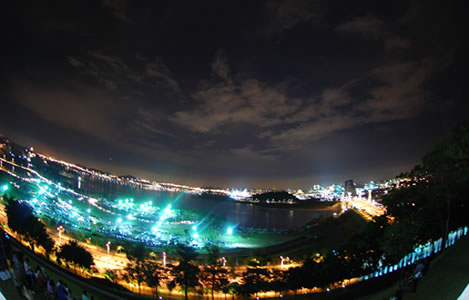|
Finding Little India in Kuala Lumpur

Photograph: Preeti Verma Lal
Talk déjà vu across 3,000 miles and few seas beyond home. In a beautiful land which is hemmed by beryl waters, where orchids bloom in the rays of the sun and skyscrapers glisten in the shadow of a shimmering moon, where the food is scrumptious and the people warm and friendly. In an island where you see so much of India that you wonder whether you have walked from home into another - a journey not akin to that of a traveller but quite like going to the neighbour’s house.
I found India in Kuala Lumpur. In Jalan Masjid India, a street that takes its name from the Jalan Masjid that was built in 1870 for the Indian Muslims who had trooped to Malaysia at the height of the tin-mining boom. As I stood at the crossroads, all physical boundaries that divide one nation from another got blurred. There were rows and rows of shops selling bright sarees and Indian dresses, a woman wearing a veil was doing brisk business peddling sugarcane juice, a man in a red shirt was hawking in Telugu, women wearing bindis on the forehead and jasmine in their hair were haggling in Tamil over the price of gold in Madras Jewellers…
Spread across several streets, signboards scream their Indian connection: Sangeetha Restaurant, Nair Dental, Peerbhai Store, Chennai Jewellers, Bombay Jewellers, Umang Umang Store, Rajshri Beauty Parlour….Even in the cacophony of an ordinary day, you would come across a whisper in Gujarati and a sentence in Hindi, a familiar-looking face smiling merely to connect and known aroma throwing in decipherable milieu. What is now a bustling Little India was once a dusty street on the outskirts of the city of Kuala Lumpur. The first Indians came here for barter trade, more followed when the British brought Indians to work in the sugarcane plantations and tin factories. Several decades later, for thousands of Indians Malaysia became their favourite home; today, Indians account for 10% of the total population.
Hari Krishnan left behind his sleepy village near Kanyakumari 15 years ago; he has not returned home since then. He works in Madras Jewellery and calls Malaysia his home. “Everything is here now, there is no need to go back,” he adds, polishing a gleaming gold pendant. For Mohammad Sadiq, the memories go back to more than 50 years when his father took a boat from the coast of Tamil Nadu. The year: 1956. The dream: A better life for his family in Ramnat district. But as luck would have it, his father did not live too long. As if continuing in his father’s footsteps and fulfilling an incomplete dream, Sadiq came to Kuala Lumpur a year ago. He found work in a newspaper kiosk. Some day Sadiq wants to own a business, but right now he has to stay content with the meagre savings that he makes every month. His friend shares similar fate. The son of a farmer, V Veerajan was destined to toil in the three acres of land that the family owned. But the coffers were shrinking and Veerajan decided to do what most people from his village did – take the flight to KL to find greener pasture. He saves roughly Rs one lakh a year and gets nostalgic about home everyday; he wants to go back but is not sure when. “Life is much better in India, but there is no money there. That is why I am here,” he says.
As I walk into Haniffa Textiles, the largest textile store in Little India, I see sarees straight out of Indian looms, bright sarees with zari borders, salwar sets in latest Bollywood designs, spices and condiments so Indian that wandering around the large shop you would forget that you are some 3,000 miles from home. And do not get surprised by the Indianness of Haniffa, it was founded by an Indian who has now made Singapore his home.
However, nostalgia is not everyone’s refrain. Andrew Ambrose of Aryan restaurant, rated one of the best Indian joints in KL, has no memories of India. He is the fourth generation Indian and all he knows of India is that fact that his great-grandfather came somewhere from South India. For Ambrose, other facts are irrelevant, what is relevant is the Indian food that he serves in his restaurant and paeans that gourmands sing to his culinary skills.
I had spent hours in Little India, listening to stories that date back to an age far back in time when the first boats packed with Indians started anchoring in the island. In those few hours I thought I had seen enough of home away from home. But as I drove towards Penang, by the Batu caves I saw Lord Muruga, a 42.7 metre high golden statute lording over a pint-sized island.
Forget people, in Kuala Lumpur even god had a familiar face. If this is not déjà vu, what is?
Published
in India Post (USA), 2008
|

